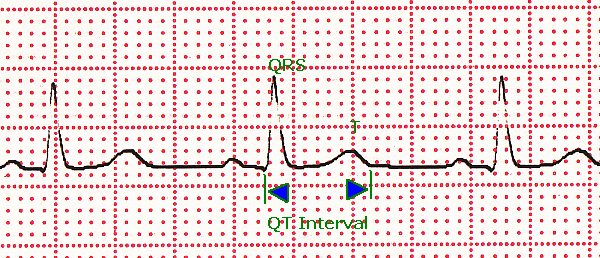Fridericia formula for QT interval correction
Fridericia formula for QT interval correction

Measurement of QT interval is very important because of the potential for life threatening torsade de pointes in the presence of QT interval prolongation. QT interval measurement is very important in the evaluation of any new drug because several drugs have been withdrawn in the past due to QT prolongation and life threatening cardiac arrhythmias. QT interval varies with heart rate, shortening with increase in heart rate. Hence it is usual practice to correct the QT interval for a heart rate of 60 per minute. Fridericia formula for QT interval correction was one of the earliest to be described [1]. The most commonly used is the Bazett formula while the others are Fridericia, Hodges, and Framingham formulas. While Bazett and Fridericia are logarithmic corrections, Hodges and Framingham are linear correction formulae.
Bazett’s formula for QT interval correction: QT / (RR)1/2
[Observed QT interval divided by root of RR interval in seconds]
Fridericia formula for QT interval correction: QT / (RR)1/3
[Observed QT interval divided by cube root of RR interval in seconds]
Both these formulae were described long back and the initial studies involved only a very small number of patients of around 30 [1,2] while Framingham formula was backed by a study of around 5000 patients. But Framingham formula is cumbersome to be used at bedside being a linear regression equation (Framingham formula: QT + 0.154 (1 – RR).
After studying over ten thousand ECGs, Luo and colleagues (Prof. Peter Macfarlane’s group) [3] opined that upper normal limits of corrected QT interval (excluding the top two percent) should be 460 millisecond for Fridericia formula. The value recommended for Bazett formula was 483 milliseconds while 457 milliseconds was suggested for both Hodges formula and Framingham formula.
It is usually mentioned that Bazett formula inappropriately increases corrected QT interval at higher heart rates, while Fridericia formula for QT interval correction does not. Charbit B et al in their study of 108 patients found that automatic QT correction using Bazett formula had a sensitivity for detection of QT prolongation of 54% while automatic QT correction using Fridericia formula had 100% sensitivity [4].
However another study reported that both Bazett and Fridericia formulas overestimates the change in QT interval even in the heart rate range of 60-120, while the linear regression formulas of Framingham and Hodges were accurate in this range of heart rates [5].
References
- Fridericia LS. The duration of systole in the electrocardiogram of normal subjects and of patients with heart disease. Acta Medica Scandinavica. 1920;53: 469-486.
- Bazett HC. An analysis of the time-relations of electrocardiograms. Heart. 1920;7: 353–370.
- Luo S, Michler K, Johnston P, Macfarlane PW. A comparison of commonly used QT correction formulae: the effect of heart rate on the QTc of normal ECGs. J Electrocardiol. 2004;37 Suppl:81-90.
- Charbit B, Samain E, Merckx P, Funck-Brentano C. QT interval measurement: evaluation of automatic QTc measurement and new simple method to calculate and interpret corrected QT interval. Anesthesiology. 2006;104:255-60.
- Indik JH, Pearson EC, Fried K, Woosley RL. Bazett and Fridericia QT correction formulas interfere with measurement of drug-induced changes in QT interval. Heart Rhythm. 2006; 3:1003–1007.

